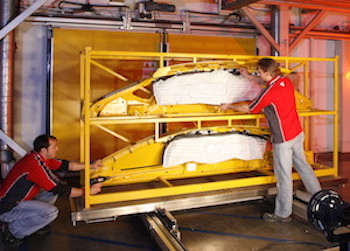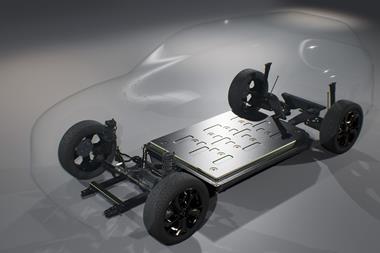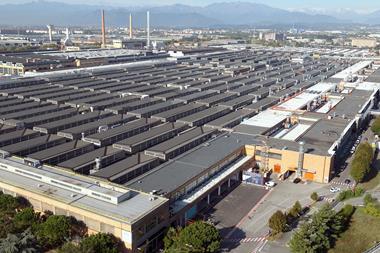Inflated market growth and faulty technology mean both problems and opportunities for airbag production
 The airbag sector is unfortunately probably best known at present for its recall problems, especially those involving the Japanese supplier Takata. While Takata has been by far the worst offender in delivering faulty airbags, or more particularly airbag inflators, it is not alone here. The sector has experienced phenomenal growth in recent years, and in developed markets, driver, passenger and side airbags are standard on just about every new vehicle, with many new cars and light trucks having eight or more bags somewhere inside. More applications, both inside – and indeed outside – the vehicle are being developed, as discussed below.
The airbag sector is unfortunately probably best known at present for its recall problems, especially those involving the Japanese supplier Takata. While Takata has been by far the worst offender in delivering faulty airbags, or more particularly airbag inflators, it is not alone here. The sector has experienced phenomenal growth in recent years, and in developed markets, driver, passenger and side airbags are standard on just about every new vehicle, with many new cars and light trucks having eight or more bags somewhere inside. More applications, both inside – and indeed outside – the vehicle are being developed, as discussed below.
The market has a complex supply chain, at the top of which sit the airbag module suppliers, of which there are three major global players – Autoliv, ZF TRW and Takata – along with a limited number of smaller suppliers such as Nihon Plast of Japan and US-based but now Chinese-owned KSS. An airbag module consists of several parts, including an inflator and electronic control unit (ECU), as well as the bag itself. The supply chain is spread over several continents, involving a multitude of suppliers.
While the major airbag companies are vertically integrated and could, in theory, make all of the parts in an airbag module, they do not have sufficient capacity to do so. Accordingly, they rely on a network of sub-suppliers as well as their own component plants. In addition, there is a significant amount of cross-supply of parts, especially of inflators and ECUs, and it is (or has been) commonplace, for example, to find an Autoliv airbag with a Takata inflator and an ECU or other parts from different suppliers.

This dispersed supply chain has undoubtedly contributed to the problems of the inflator recall crisis; matching all the potentially problematic inflators to the vehicles in which they have been fitted has been neither quick nor easy.
The specific problem at Takata derives from its decision to use ammonium nitrate as the propellant; this chemical can degrade if exposed to too much heat and humidity, and once this happens the explosion upon airbag activation can rupture the metal housing, causing the airbag itself to deploy incorrectly.
Takata has committed to replacing ammonium nitrate with guanidine nitrate, a material which has been used by TRW and Autoliv for many years, without problems (to date). However, as more and more vehicles have been identified with problematic inflators, the scale of the problem has become too big for one company to handle on its own; as well as needing to redesign inflators to use a different propellant, Takata has had to accept that its competitors, notably Autoliv and TRW, as well as the inflator specialist Daicel, will supply most of the ever-growing number of replacement inflators. In fact, 90% of the required replacements are expected to be made by companies other than Takata.
Relying on a complex supply chainThe key stages in the airbag supply chain are as follows:
• Airbag fabric is woven by textile specialists such as Toray, Asahi, Global Safety Textiles, Toyota Boshoku and Teijin, from where it is typically transported to a coating plant. Silicone coatings are applied to fabric which could potentially come into contact with occupants’ faces; the coating is designed to cool the air within the bag which is heated very quickly upon deployment and also to prevent any fragments coming through the bag.
• After coating (which is not necessary on foot or knee bags, for example), the fabric is taken to a cut-and-sew operation, often in low-cost locations; much of the airbag material used in Europe is cut and sewn in locations such as Romania, Ukraine, Moldova or Morocco. A good example is the case of TRW Romania which (just as TRW was in the midst of its merger with ZF) opened a cut-and-sew operation at Roman, Romania, as part of its plans to make an additional 12m bags by 2018. This plant will employ 1,000 people by 2017 and will work alongside other ZF TRW plants in Romania which make die castings and small foam parts as well as assembling complete bags and wrapping steering wheels.
• From the cut-and-sew operation, the material is taken to the airbag assembly plant, where it is folded (if not already folded) and put inside a housing along with other elements of the airbag module, ie the ignitor, inflator and ECU which controls airbag deployment. The complete module is sent either to the car plant for installation on the assembly line, or to a tier-one assembler if the bag is fitted inside another component; for example, side bags tend to come out of the seat, while front-passenger bags have to be fitted into the dashboard assembly. Driver airbags are fitted into the steering wheel, mostly but not always at the steering-wheel assembler’s site.
A changing manufacturing footprintWhile driver, passenger and side airbags are standard items in developed markets, fitment rates are much lower in countries such as India. As a result, airbag production capacity is now starting to be installed in these markets, for both incipient and the expected huge growth in demand. For example, in 2015, ZF TRW opened a new airbag plant in Chennai, to supply Ford initially. Its capacity is quite modest, at just 500,000 airbags a year, although the site has the space to grow substantially.
In parallel with expansion in emerging markets, the inflator recall problem has resulted in a significant expansion of manufacturing activity in developed markets. Autoliv, which met some of the initial demand for extra inflators from its under-utilised plants in China, has had to install 12 more inflator production lines at existing factories, notably in Utah, to make an additional 20m inflators through to 2018; even this huge number could be insufficient, with Autoliv CEO Jan Carlson recently telling analysts that the inflator problem was “a fluid issue”. Certainly, Autoliv itself has benefitted from Takata’s problems, winning new contracts in airbag modules and inflators at the Japanese company’s expense. For example, the turnover of its Romanian business grew by 25% to nearly €686m ($780m), making it the 27th-biggest company in Romania.
Takata had tried to address the problem by doubling inflator production during 2015 and opening two new inflator production lines in Monclova, Mexico, in early 2016. But this was not enough, and in addition to the expansion at Autoliv, Daicel has brought forward plans for a second US factory to 2016, having originally scheduled it for next year; this will allow the company to meet demand for the replacement inflator contracts it has won from Takata’s North American customers.
Takata losing customers and market rankingAs a result of the inflator recall, the future for Takata – once the undisputed the leader in airbags and seat belts in Japan, and a major player in North America and Europe – is very uncertain. Several companies, notably Honda and Ford, have stated that they will no longer use Takata airbags. Mazda and Toyota have said that they will not use Takata for ammonium-nitrate inflators, but could deal with the company if it used a different propellant. There have been reports of specialist restructuring advisers having been appointed, while Takata’s banks and shareholders will likely be expected to provide significant capital to see it through its current challenges.
By the start of May 2016, the US authorities had issued recalls for cars containing over 90m airbags with Takata inflators. The scale of the manufacturing activity – and work by retrofitting garages – required to replace all these inflators is enormous, and while there may have been some initial slack in the production system, there was certainly not enough to produce an additional 90m inflators quickly.
It has also proven very difficult to put a total cost on this exercise, with Reuters reporting $9 billion as a starting point, based on the idea of 90m inflators being replaced at a unit cost of $100. This excludes the fitting costs and time involved, especially for the customers affected. However, in March 2016 (ie before the 90m total had been reached) Takata suggested a worst-case cost of up to $24 billion. It would seem likely that the total cost will be higher than this. In the immediate future, Takata is expected to report a loss of around 13 billion yen ($121.4m) for the 2015-2016 financial year; this is unlikely to be reversed any time soon.
 From the cut-and-sew operation, the material is taken to the assembly plant and housed with units that control deployment
From the cut-and-sew operation, the material is taken to the assembly plant and housed with units that control deploymentSince most of the replacement inflators and those needed for other new contracts will be supplied by Takata’s competitors, its market share is expected to fall from around 22% worldwide to just 5% by the end of the decade. In turn, this creates opportunities for the company’s rivals. For example, ZF TRW expects to become the second-ranked inflator supplier, after Autoliv, as it benefits from the Takata recall, winning contracts from Honda and Fiat Chrysler very quickly, with more contracts likely. ZF TRW’s initial contract from Fiat Chrysler, for example, was for 4.1m replacement driver airbag inflators.
While Takata is the worst offender in terms of supplying faulty airbags, it is worth noting that other companies are far from problem-free. On a more modest scale, Ford recalled 37,000 Transit vans in the US owing to a fault with the side airbags – supplied by ZF TRW in Mexico. In Japan, Honda has recalled 143,000 vehicles featuring airbag modules from Nihon Plast and inflators from Daicel, one of the companies benefitting from the additional inflator business arising from the Takata problems. TRW has also been caught up in the Takata recall because of a faulty electronic part it sold into the same airbag modules which used Takata inflators. In the US, Honda has reportedly been recovering Takata inflators from Honda models at scrapyards, to prevent them being stripped from the cars and then sold into the unofficial aftermarket.
Evolving new applicationsZF TRW is not, however, simply relying on taking business from Takata for its growth in airbags. As well as featuring a complex supply chain, the airbag market is constantly evolving technologically, with new airbag applications appearing regularly. At the end of 2015, ZF TRW launched a centre airbag which pops up between the front two passengers to prevent them hitting each other, especially each other’s heads, in the event of a side-on crash. It has developed this technology in response to findings which show that as many as 30% of side-impact fatalities involve the passenger on the opposite side to the impact; in addition, up to 30% of serious injuries in side impacts also involve what the industry calls far-side collisions.
 Centre airbags are one example of how the sector is constantly evolving new applications
Centre airbags are one example of how the sector is constantly evolving new applicationsThere are already some centre airbags in use, ironically supplied by Takata, namely on General Motors’ Buick Enclave, GMC Acadia and Chevrolet Traverse crossovers. Side-impact crashes will assume a much bigger role in the Euro New Car Assessment Programme from 2018, so we can expect to see these airbags appearing regularly in the near future. In addition, in the coming years we will see cars with airbags which pop up from beneath the bonnet on impact to minimise injuries to pedestrians.
Another development, announced by ZF TRW in early 2016, for use from 2020, will see an airbag deploy from just under the wheel arch. Having around twice the air volume of a conventional, internal curtain side airbag, it will require two inflators to fill the 200-litre bag. It is claimed that this will reduce impact damage by 30%
TRW has another new airbag application, launched on the Citroen C4 Cactus: a roof-mounted airbag which replaces the passenger airbag in the dashboard and frees up space there for storage and other electronics, as well as allowing greater flexibility in interior design. In the C4 Cactus, the airbag is mounted under the headliner at the front of the car and will deploy in front of the windscreen.
Expecting more changesThe airbag sector is undergoing significant structural change and could well see the disappearance of one of its market leaders; at the very least, a form of restructuring at Takata, along the lines of a US Chapter 11 process, may be required for the company to survive.
The sector also continues to grow as more and more airbags are fitted, not just to vehicles in the developed world, but also in emerging markets. This is resulting is an expansion of manufacturing capacity across the globe, with the likelihood of more to come. While this is happening, market leader Autoliv is reinventing itself, reducing its dependence on airbags, despite the continued growth in demand for the product. It is moving into autonomous driving and braking and a wide range of active safety systems. The story of this dynamic new market will be told another day.


































